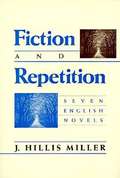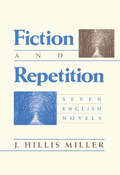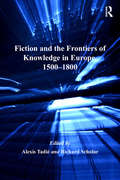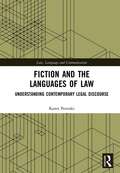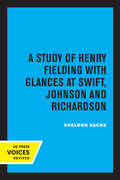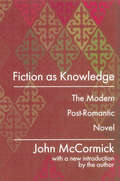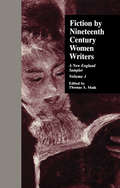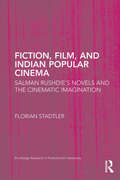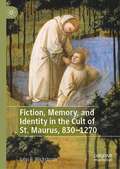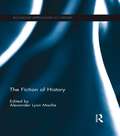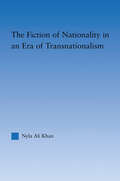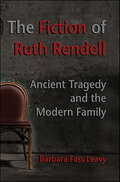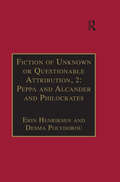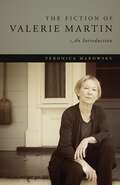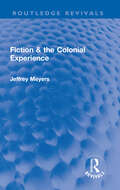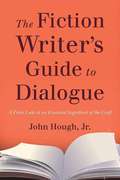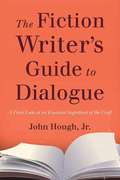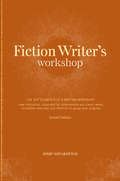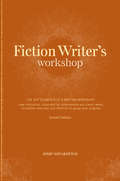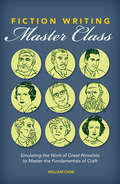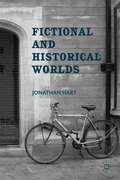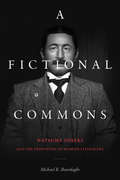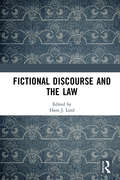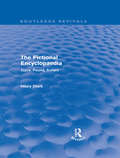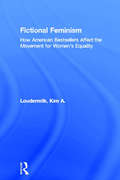- Table View
- List View
Fiction and Repetition: Seven English Novels
by J. Hillis Miller<p>In Fiction and Repetition, one of our leading critics and literary theorists offers detailed interpretations of seven novels: Emily Brontë's Wuthering Heights, Thackeray's Henry Esmond, Hardy's Tess of the d'Urbervilles and The Well-Beloved, Conrad's Lord Jim, and Woolf's Mrs. Dalloway and Between the Acts. Miller explores the multifarious ways in which repetition generates meaning in these novels―repetition of images, metaphors, motifs; repetition on a larger scale of episodes, characters, plots; and repetition from one novel to another by the same or different authors. While repetition creates meanings, it also, Miller argues, prevents the identification of a single determinable meaning for any of the novels; rather, the patterns made by the various repetitive sequences offer alternative possibilities of meaning which are incompatible. He thus sees “undecidability” as an inherent feature of the novels discussed. <p>His conclusions make a provocative contribution to current debates about narrative theory and about the principles of literary criticism generally. His book is not a work of theory as such, however, and he avoids the technical terminology dear to many theorists; his book is an attempt to interpret as best he can his chosen texts. Because of his rare critical gifts and his sensitivity to literary values and nuances, his readings send one back to the novels with a new appreciation of their riches and their complexities of form.</p>
Fiction and Repetition: Seven English Novels
by J. Hillis MillerIn Fiction and Repetition, one of our leading critics and literary theorists offers detailed interpretations of seven novels: Emily Brontë's Wuthering Heights, Thackeray's Henry Esmond, Hardy's Tess of the d'Urbervilles and The Well-Beloved, Conrad's Lord Jim, and Woolf's Mrs. Dalloway and Between the Acts. Miller explores the multifarious ways in which repetition generates meaning in these novels—repetition of images, metaphors, motifs; repetition on a larger scale of episodes, characters, plots; and repetition from one novel to another by the same or different authors. While repetition creates meanings, it also, Miller argues, prevents the identification of a single determinable meaning for any of the novels; rather, the patterns made by the various repetitive sequences offer alternative possibilities of meaning which are incompatible. He thus sees “undecidability” as an inherent feature of the novels discussed. His conclusions make a provocative contribution to current debates about narrative theory and about the principles of literary criticism generally. His book is not a work of theory as such, however, and he avoids the technical terminology dear to many theorists; his book is an attempt to interpret as best he can his chosen texts. Because of his rare critical gifts and his sensitivity to literary values and nuances, his readings send one back to the novels with a new appreciation of their riches and their complexities of form.
Fiction and the Frontiers of Knowledge in Europe, 1500-1800
by Richard Scholar Alexis TadiéThe uses of fiction in early modern Europe are far more varied than is often assumed by those who consider fiction to be synonymous with the novel. The contributors to this volume demonstrate the significant role that fiction plays in early modern European culture, not only in a variety of its literary genres, but also in its formation of philosophical ideas, political theories, and the law. The volume explores these uses of fiction in a series of interrelated case studies, ranging from the Italian Renaissance to the French Revolution and examining the work of, among others, Montaigne, Corneille, Descartes, Hobbes, Locke, and Diderot. It asks: Where does fiction live, and thrive? Under what conditions, and to what ends? It suggests that fiction is best understood not as a genre or a discipline but, instead, as a frontier: one that demarcates literary genres and disciplines of knowledge and which, crucially, allows for the circulation of ideas between them.
Fiction and the Languages of Law: Understanding Contemporary Legal Discourse (Law, Language and Communication)
by Karen PetroskiContemporary legal reasoning has more in common with fictional discourse than we tend to realize. Through an examination of the U.S. Supreme Court’s written output during a recent landmark term, this book exposes many of the parallels between these two special kinds of language use. Focusing on linguistic and rhetorical patterns in the dozens of reasoned opinions issued by the Court between October 2014 and June 2015, the book takes nonlawyer readers on a lively tour of contemporary American legal reasoning and acquaints legal readers with some surprising features of their own thinking and writing habits. It analyzes cases addressing a huge variety of issues, ranging from the rights of drivers stopped by the police to the decision-making processes of the Environmental Protection Agency—as well as the term’s best-known case, which recognized a constitutional right to marriage for same-sex as well as different-sex couples. Fiction and the Languages of Law reframes a number of long-running legal debates, identifies other related paradoxes within legal discourse, and traces them all to common sources: judges’ and lawyers’ habit of alternating unselfconsciously between two different attitudes toward the language they use, and a set of professional biases that tends to prevent scrutiny of that habit.
Fiction and the Shape of Belief: A Study of Henry Fielding with Glances at Swift, Johnson and Richardson
by Sheldon SacksThis title is part of UC Press's Voices Revived program, which commemorates University of California Press’s mission to seek out and cultivate the brightest minds and give them voice, reach, and impact. Drawing on a backlist dating to 1893, Voices Revived makes high-quality, peer-reviewed scholarship accessible once again using print-on-demand technology. This title was originally published in 1967.
Fiction as Knowledge: Modern Post-romantic Novel
by John McCormickCritics of fiction have long been aware that the romantic movement in Europe and America gave a powerful impulse to the art of fiction. The exact nature of that impulse has resisted analysis like so much associated with romanticism. In Fiction as Knowledge John McCormick reaches for precision, proposing that much of the vitality of modern fiction derives from romantic conceptions of history which made available to fiction not merely historical subject matter, but new perceptions of reality, present and past, that pervade the work of many of the greatest writers of the post-romantic period.Beginning with Herder and Hegel, McCormick describes those qualities in historical thought that were revolutionary in the early nineteenth century and rich in meaning for the future. Most prominent of these was the emergence of the idea of individuality, not only in society but also in history. The author demonstrates the vitality of the romantic impulse in the work of seven major novelists of the twentieth century. Marcel Proust's apprehensions of nature in his great novel are seen as Wordsworthian, while as the novel unfolds, history in the form of event and system of organization comes to dominate and to offer a paradigm of the workings of the post-romantic historical imagination. William Faulkner and Andr Malraux are shown to confront history directly, although they do not write "historical" fiction. Herman Broch, Robert Musil, and Henri de Montherlant, uncomfortable with traditional romantic attitudes, still make fullest use of Romantic historical insight to extend the range of fiction as knowledge. Ernest Hemingway, by contrast, is seen as intuitive, a pure product of his novelist's intelligence as opposed to his latter-day romantic anti-intellectualism.Fiction as Knowledge supplies critical insight into the form of the novel as well as into the seven novelists under discussion. Not least, the book is a warning against contemporary anti-historical bias and an appeal to the cultivation of historical consciousness. John McCormick is Professor Emeritus of Comparative Literature at Rutgers University, and Honorary Fellow of English and Literature at the University of York. He is the author of George Santayana: A Biography, Catastrophe and Imagination, and The Middle Distance, by Transaction.
Fiction by Nineteenth-Century Women Writers: A New England Sampler (Gender and Genre in Literature #10)
by Thomas A. MaikIn an era following the Civil War which saw change and transformation everywhere, new magazines emerged to record and report the change. Responding to the call for material to fill their pages, writers in regions such as New England, the West, and the South answered, most often with short stories. In fact, short fiction became the literature of choice for an emerging mass audience. And increasingly the voices of women writers found resonance in the pages of Harper's New Monthly ,Putnam's, and Galaxy, to name a few of the newly established magazines. In New England, writers such as Sarah Orne Jewett, Mary Wilkins Freeman, Harriet Beecher Stowe, Louisa May Alcott, Harriet Prescott Spofford, Sarah Johnson Prichard, and Rose Terry Cooke found a voice within the pages of these magazines. Although read widely in the late nineteenth century, increasingly these women writers-with a few exceptions-began to be marginalized early-on in the twentieth century. Besides expanding the canon, this collection of selected short stories by these seven New England writers attempts to restore what has been for many of them in this century either a diminished or even a lost voice.
Fiction, Film, and Indian Popular Cinema: Salman Rushdie’s Novels and the Cinematic Imagination (Routledge Research in Postcolonial Literatures #48)
by Florian StadtlerThis book analyses the novels of Salman Rushdie and their stylistic conventions in the context of Indian popular cinema and its role in the elaboration of the author’s arguments about post-independence postcolonial India. Focusing on different genres of Indian popular cinema, such as the ‘Social’, ‘Mythological’ and ‘Historical’, Stadtler examines how Rushdie’s writing foregrounds the epic, the mythic, the tragic and the comic, linking them in storylines narrated in cinematic parameters. The book shows that Indian popular cinema’s syncretism becomes an aesthetic marker in Rushdie’s fiction that allows him to elaborate on the multiplicity of Indian identity, both on the subcontinent and abroad, and illustrates how Rushdie uses Indian popular cinema in his narratives to express an aesthetics of hybridity and a particular conceptualization of culture with which ‘India’ has become identified in a global context. Also highlighted are Rushdie’s uses of cinema to inflect his reading of India as a pluralist nation and of the hybrid space occupied by the Indian diaspora across the world. The book connects Rushdie’s storylines with modes of cinematic representation to explore questions about the role, place and space of the individual in relation to a fast-changing social, economic and political space in India and the wider world.
Fiction, Memory, and Identity in the Cult of St. Maurus, 830–1270
by John B. WickstromThis book explores one of the most significant medieval saints’ cults, that of St. Maurus, the first known disciple of Saint Benedict. Despite the centrality of this story to the myth of medieval Benedictine culture, no major scholarly work has been devoted to Maurus since the late nineteenth century. Drawing on memory studies, this book investigates the origins and history of the cult, from the ninth-century Life of St. Maurus by Odo, abbot of Glanfueil, to its appropriation and re-shaping by three powerful abbeys through to the thirteenth century—Fossés, Cluny, and Montecassino. It traces how these institutions deployed caches of mostly forged documents (many translated here for the first time) to adapt the cult to their aspirations and, moreover, considers how the cult adapted itself further, to face the challenges of the modern world.
The Fiction of History (Routledge Approaches to History)
by Alexander Lyon MacfieThe Fiction of History sets out a number of themes in the relationship between history and fiction, emphasising the tensions and dilemmas created in this relationship and examining how various writers have dealt with these. In the first part, two chapters discuss the philosophy behind the connection between fiction and history, whether history is fiction, and the distinction between the past and history. Part two goes on to discuss the relationship between history and literature using case studies such as Virginia Woolf and Charles Dickens. Part three looks at television and film (as well as other media) through case studies such as the film Welcome to Sarajevo and Soviet and Australian films. Part four considers a particular theme that has prominence in both history and literature, postcolonial studies, focusing on the issues of fictions of nationhood and civilization and the historical novel in postcolonial contexts. Finally, the fifth section comprises two interviews with novelists Penelope Lively and Adam Thorpe and discusses the ways in which their works explore the nature of history itself.
The Fiction of Nationality in an Era of Transnationalism (Literary Criticism and Cultural Theory)
by Nyla Ali KhanFirst Published in 2005. Routledge is an imprint of Taylor & Francis, an informa company.
The Fiction of Ruth Rendell: Ancient Tragedy and the Modern Family
by Barbara Fass LeavyA study of the role of family, ancient Greek narratives, and the psychological theories of Freud and Jung in the mystery novels of Ruth Rendell. Aside from Ruth Rendell&’s brilliance as a fiction writer, and her appeal to mystery lovers, her books portray a compelling, universal experience that her readers can immediately relate to, the intra-familial stresses generated by the nuclear family. Even those who experience the joys as well as pains of family life will find in Rendell the conflicts that beset all who must navigate their way through the conflicts that beset members of the closest families. Barbara Fass Leavy analyzes the multi-leveled treatment of these themes that contributes to Rendell&’s standing as a major contemporary novelist. Rendell, who also writes as Barbara Vine, draws on ancient Greek narratives, and on the psychological theories Sigmund Freud and Carl Jung derived from them, to portray the disturbed family relationships found throughout her work. Leavy&’s analysis considers what distinguishes mysteries as popular entertainment from crime fiction as literary art. The potential for rereading even when the reader remembers &“whodunit&” will be the basis for this distinction. Leavy also looks closely at the Oedipus and Electra complexes and how they illuminate Rendell&’s portrayals of the different pairings within the nuclear family (for example, mother and daughter) and considers the importance of gender differences. In addition, Leavy corrects a widespread error, that Freud formulated the Electra complex, when in fact the formulation was Jung&’s as he challenged Freud&’s emphasis on the Oedipus story as the essential paradigm for human psychological development.
Fiction of Unknown or Questionable Attribution, 2: Printed Writings 1641–1700: Series II, Part Three, Volume 10 (The Early Modern Englishwoman: A Facsimile Library of Essential Works & Printed Writings, 1641-1700: Series II, Part Three #Vols. 9-10)
by Erin Henriksen Desma PolydorouThe second of two volumes of 'Fiction of unknown or questionable authorship, 1641-1700,' this volume presents in facsimile two seventeenth-century novels, Alcander and Philocrates: Or, The Pleasures and Disquietudes of Marriage. A Novel. Written by a Young Lady (1696) and Peppa, or The Reward of Constant Love a novel: done out of French: with several songs set to musick for two voices / by a young-gentlewoman (1689). The first of these is an original, unattributed work written in English; the second is a translation from the French for which there is some evidence of a female translator. An original introduction to the volume provides information about the content of each novel; what the authors have discovered about each work's publication and authorship; and the physical copies of the seventeenth century books from which the facsimiles are taken.
The Fiction of Valerie Martin: An Introduction
by Veronica MakowskyIn the first book-length study of Valerie Martin's fiction, Veronica Makowsky explores the work of this lauded, but often overlooked, contemporary novelist. Winner of the Orange Prize for her novel Property (2003), Martin also won the Kafka Prize for Mary Reilly (1990), which was then translated into sixteen languages and made into a popular film. Despite these successes, her critically acclaimed novels and stories have yet to attain a broad readership. Makowsky addresses this disconnect through a detailed critical study of Martin's distinguished oeuvre, grounding each work in its historical, cultural, and theoretical contexts. Makowsky begins with a sketch of Martin's life and then considers each of her ten novels and four collections of short stories. Throughout, Makowsky's deft critique reveals Martin to be an astute observer of people and places. Pointing to both early works, like A Recent Martyr (1987), and recent books, such as The Ghost of the Mary Celeste (2014), Makowsky identifies a potent mixture of pleasure and fear in Martin's writing that emphasizes the author's nuanced exploration of human imagination. Notable, too, are Martin's literary techniques -- especially point of view -- and her allusions to masterpieces in Western literature. The works of Henry and William James in particular influenced Martin's thematic blend of intellectualism and empathy evident in her rounded depictions of women in works like Italian Fever (1999) and The Great Divorce (1994). A rich and substantive study, The Fiction of Valerie Martin demonstrates and deconstructs the mastery of this thought-provoking author, in turn firmly establishing Martin's place in the canon of contemporary writers.
Fiction & the Colonial Experience (Routledge Revivals)
by Jeffrey MeyersBritish colonialism provided a rich vein of material for the novelists of the first half of the 20th century. This study, originally published in 1968, looks at five writers and their reaction to the Empire: Rudyard Kipling, E. M. Forster, Joseph Conrad, Joyce Cary and Graham Greene. It shows how the romantic adventure stories of Kipling’s early days, in which the indigenous population plays almost no part, gave rise to the much more important novels of spiritual and moral conflict in which the stereotyped values of Empire are questioned. The decline of colonialism from its apogee in the 1880s within a relatively short period makes the novels discussed a compact group, so that not only is the use of colonial material closely studied, but its impact on the novelists themselves emerges clearly. This is an important study of a major literary theme, linking modern literature and modern history at a vital point.
The Fiction Writer's Guide to Dialogue
by John Hough Jr.Dialogue is often overlooked as a necessary and potent instrument in the novelist's repertoire. A novel can rise or fall on the strength of its dialogue. Superb dialogue can make a superb novel. F. Scott Fitzgerald wrote, "Action is character." George V. Higgins said, "Dialogue is character." They were both right, because dialogue is action. It comprises much, if not all, of the clarifying drama of any novel. How much physical action can there be in 300 pages, even in a crime novel or a thriller? And all conflict, even physical, begins as dialogue.Hough explains how dialogue can reveal a character's nature as well as his or her defining impulses and emotions. He says there must be tension in every colloquy in fiction, and shows the reader ways to achieve it. Hough illustrates his precepts with examples from his own work and from that of the best modern writers of dialogue, including Cormac McCarthy, Kent Haruf, Joan Didion, Annie Proulx, Lee Smith, Elmore Leonard, George V. Higgins, William Kennedy and Howard Frank Mosher. He cites early 20th century writers who refined and advanced dialogue as an art form: Ernest Hemingway, Ring Lardner, Dorothy Parker, and William Saroyan.Hough's novel Seen the Glory: A Novel of the Battle of Gettysburg was praised by Lee Smith as containing "the best dialogue of the period I have ever read." Hough on Dialogue will give writers and aspiring writers a fresh look at one of the essential ingredients of their craft.
The Fiction Writer's Guide to Dialogue: A Fresh Look at an Essential Ingredient of the Craft
by John Hough Jr.Dialogue is often overlooked as a necessary and potent instrument in the novelist’s repertoire. A novel can rise or fall on the strength of its dialogue. Superb dialogue can make a superb novel. F. Scott Fitzgerald wrote, "Action is character.” George V. Higgins said, "Dialogue is character.” They were both right, because dialogue is action. It comprises much, if not all, of the clarifying drama of any novel. How much physical action can there be in 300 pages, even in a crime novel or a thriller? And all conflict, even physical, begins as dialogue.Hough explains how dialogue can reveal a character’s nature as well as his or her defining impulses and emotions. He says there must be tension in every colloquy in fiction, and shows the reader ways to achieve it. Hough illustrates his precepts with examples from his own work and from that of the best modern writers of dialogue, including Cormac McCarthy, Kent Haruf, Joan Didion, Annie Proulx, Lee Smith, Elmore Leonard, George V. Higgins, William Kennedy and Howard Frank Mosher. He cites early 20th century writers who refined and advanced dialogue as an art form: Ernest Hemingway, Ring Lardner, Dorothy Parker, and William Saroyan.Hough’s novel Seen the Glory: A Novel of the Battle of Gettysburg was praised by Lee Smith as containing "the best dialogue of the period I have ever read.” Hough on Dialogue will give writers and aspiring writers a fresh look at one of the essential ingredients of their craft.Allworth Press, an imprint of Skyhorse Publishing, publishes a broad range of books on the visual and performing arts, with emphasis on the business of art. Our titles cover subjects such as graphic design, theater, branding, fine art, photography, interior design, writing, acting, film, how to start careers, business and legal forms, business practices, and more. While we don't aspire to publish a New York Times bestseller or a national bestseller, we are deeply committed to quality books that help creative professionals succeed and thrive. We often publish in areas overlooked by other publishers and welcome the author whose expertise can help our audience of readers.
Fiction Writer's Wokrshop
by Josip NovakovichMaster the Elements of the Writing Workshop The great paradox of the writing life is that to be a good writer, you must be both interested in the world around you and comfortable working in solitude for hours on end. Fiction Writer's Workshop is designed to help you foster a strong sense of independence#150;of being and thinking on your own, of becoming self-evaluative without being self-critical#150;in order to accomplish what others seek in classroom groups. In this comprehensive guide, award-winning writer and teacher Josip Novakovich explores every aspect of the art of fiction and provides all the tools and techniques you'll need to develop day-to-day discipline as well as a personal writing style, such as: More than 100 writing exercises, including dozens that are new to this edition, that challenge you to experiment with diverse writing styles Specific statements of purpose for each exercise, to help guide you and instruct you at every step of the creative process Self-critique questions to help you assess your work and identify strengths and weaknesses before moving on to the next lesson The full text of eight acclaimed short stories, with analysis and exercises, to provide models for your own writing and help reinforce the lessons you've learned The practical, insightful methods offered in this workshop will clarify your voice, broaden your perspective, and strengthen your fiction.
Fiction Writer's Workshop: The Key Elements of a Writing Workshop
by Josip NovakovichMaster the Elements of the Writing Workshop The great paradox of the writing life is that to be a good writer, you must be both interested in the world around you and comfortable working in solitude for hours on end. Fiction Writer's Workshop, Second Edition, is designed to help you foster a strong sense of independence#151;of being and thinking on your own, of becoming self-evaluative without being self-critical#151;in order to accomplish what others seek in classroom groups. In this comprehensive guide, award-winning writer and teacher Josip Novakovich explores every aspect of the art of fiction and provides all the tools and techniques you'll need to develop day-to-day discipline as well as a personal writing style, such as: More than 100 writing exercises, including dozens that are new to this edition, that challenge you to experiment with diverse writing styles Specific statements of purpose for each exercise, to help guide you and instruct you at every step of the creative process Self-critique questions to help you assess your work and identify strengths and weaknesses before moving on to the next lesson The full text of eight acclaimed short stories, with analysis and exercises, to provide models for your own writing and help reinforce the lessons you've learned The practical, insightful methods offered in this workshop will clarify your voice, broaden your perspective, and strengthen your fiction.
Fiction Writing Master Class: Emulating the Work of Great Novelists to Master the Fundamentals of Craft
by William CaneWant to find your voice? Learn from the best! In your development as a writer, you've likely been told to develop your own unique writing style, as if it were as simple as pulling it out of thin air. But finding your voice isn't easy--it requires time, practice, and a thorough understanding of how great fiction is written. Fiction Writing Master Class analyzes the writing styles of twenty-one superior novelists including Charles Dickens, Edith Wharton, Franz Kafka, Flannery O'Connor, Ray Bradbury, and many others. This fascinating and insightful guide mines the writing secrets of these exceptional authors and shows you how to use them to develop a writing style that stands out in a crowd. You'll discover how to: Create characters as memorable as Herman Melville's Captain Ahab Master point of view with techniques from Fyodor Dostoevsky Pick up the pace by keeping your sentences lean like Ernest Hemingway Incorporate sensual details like James Bond creator Ian Fleming Add suspense to your story by following the lead of horror master Stephen King And that's not all, Fiction Writing Master Class is your key to understanding and implementing the proven techniques of history's greatest authors, taking your writing to a whole new level of excellence in the process.
Fictional and Historical Worlds
by Jonathan HartJonathan Hart examines possible and fictional worlds, author and authority, otherness and recognition, translation, alternative critique, empire, education, imagination, comedy, history, poetry, and culture. The analyzed works include classical and modern texts and theorists of the past sixty years ranging from Jerome Bruner to Stephen Greenblatt.
A Fictional Commons: Natsume Soseki and the Properties of Modern Literature
by Michael K. BourdaghsModernity arrived in Japan, as elsewhere, through new forms of ownership. In A Fictional Commons, Michael K. Bourdaghs explores how the literary and theoretical works of Natsume Sōseki (1867–1916), widely celebrated as Japan's greatest modern novelist, exploited the contradictions and ambiguities that haunted this new system. Many of his works feature narratives about inheritance, thievery, and the struggle to obtain or preserve material wealth while also imagining alternative ways of owning and sharing. For Sōseki, literature was a means for thinking through—and beyond—private property. Bourdaghs puts Sōseki into dialogue with thinkers from his own era (including William James and Mizuno Rentarō, author of Japan’s first copyright law) and discusses how his work anticipates such theorists as Karatani Kōjin and Franco Moretti. As Bourdaghs shows, Sōseki both appropriated and rejected concepts of ownership and subjectivity in ways that theorized literature as a critical response to the emergence of global capitalism.
Fictional Discourse and the Law
by Hans J. LindDrawing on insights from literary theory and analytical philosophy, this book analyzes the intersection of law and literature from the distinct and unique perspective of fictional discourse. Pursuing an empirical approach, and using examples that range from Victorian literature to the current judicial treatment of rap music, the volume challenges the prevailing fact–fiction dichotomy in legal theory and practice by providing a better understanding of the peculiarities of legal fictionality, while also contributing further material to fictional theory’s endeavor to find a transdisciplinary valid criterion for a definition of fictional discourse. Following the basic presumptions of the early law-as-literature movement, past approaches have mainly focused on textuality and narrativity as the common denominators of law and literature, and have largely ignored the topic of fictionality. This volume provides a much needed analysis of this gap. The book will be of interest to scholars of legal theory, jurisprudence and legal writing, along with literature scholars and students of literature and the humanities.
The Fictional Encyclopaedia: Joyce, Pound, Sollers (Routledge Revivals)
by Hilary ClarkFirst published in 1990, this work offers an analysis of the phenomenon of encyclopaedism in literature. Hilary Clark develops the theory of an encyclopaedic form in the interests of making clear distinctions between the realist narrative form and that of the encyclopaedic-parodic or fictional encyclopaedia. She makes clear the special links that non-realist, parodic fictions have with the forms of essay, Menippean satire and epic, and indeed with the encyclopaedia itself. The study pays particular attention to the way in which literary encyclopaedism has flourished in the twentieth century, with special reference to the works of James Joyce, Ezra Pound and Philippe Sollers.
Fictional Feminism: How American Bestsellers Affect the Movement for Women's Equality (Literary Criticism and Cultural Theory)
by Kim A. LoudermilkThis book focuses on the ways in which second-wave feminism has been represented in American popular culture, and on the effects that these representations have had on feminism as a political movement. Kim Loudermilk provides close readings of four best-selling novels and their film adaptations. According to Loudermilk, each of these novels contains explicitly feminist characters and themes, yet each presents a curiously ambivalent picture of feminism; these texts at once take feminism seriously and subtly undercut its most central tenets. This book argues that these texts create a kind of "fictional feminism" that recuperates feminism's radical potential, thereby lessening the threat it presents to the status quo.
